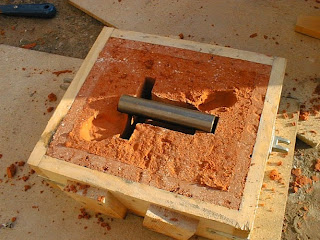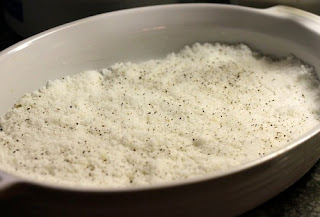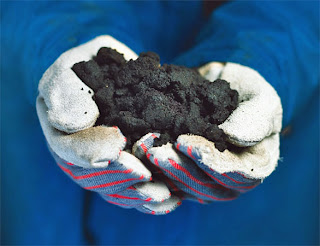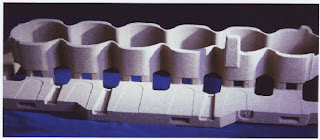MOLDING SAND
The common sources of collecting foundry sands are rivers, lakes, seas and deserts. All the foundry sands can be mainly grouped as:1. Natural sand:
Which contains sufficient amount of binding clay and therefore no more binder is required to be added to them.2. Silica sand:
Which do not possess the clay content and need addition of a suitable binder to make them usable for foundry work. They are also sometimes called sharp sands. They when mixed with some other constituents like binders and additives are also known as synthetic sands.QUALITIES OF SAND
Refractoriness:
For example steel is poured at high temperature than cast iron. Similarly cast iron is poured at high temperature than brass. Therefore, the mold for steel casting should have higher degree’s of refractoriness than that used for iron castings and latter should have more refractoriness than the one used for brass casting. If a sand lacks in this property it will fuse on coming in contact with the molten metal, iron stag on the surface of the casting and will spoil the latter.
The molding sand owes this property largely to the presence of quartz content or silica and the shape and size of its grains. Rough and larger grains lead to higher refractoriness. Similarly, a higher percentage of silica results in greater refractoriness. On the other hand iron oxides, calcium, sodium and potassium reacts chemically, during pouring of metal to form compounds which have very low melting points. Thus their presence in sand reduces its refractoriness. It should therefore be kept as low as possible particularly in those sands which are used in iron and steel foundries.
Permeability:
Flow ability or plasticity:
It is that property of sand due to which it flows during ramming to all portions of the molding flask, packs properly around the pattern to acquire the desired shape and distributes the ramming pressure evenly to all parts of mold. It increases with addition of clay and water content and reduction of green strength and grain size.Adhesiveness:
It is that property of sand due to which it is capable of adhering to the surfaces of other materials. It is entirely due to this property that the heavy sand mass is successfully held in a molding flask and manipulated as desired without any danger if its falling out. Similarly, on account of the same property, the gaggers are able to hold bulky sand projections of the mold.Cohesiveness:
It is that property of the sand due to which its rammed particles bind together firmly and the pattern is withdrawn from the mold without damaging the mold surfaces and edges. Also, due to this property the mold faces get sufficient strength to withstand the pressure of molten metal and do not get washed under this pressure. This property of the sand in green state is known as green bond or green strength and is largely effected by the grain size, clay and moisture content.When the molten metal is poured into the mold or the latter is backed in an oven, it gets dried due to the evaporation of the moisture. The cohesiveness in the sand grains is still required to give sufficient strength to the mold faces to retain their shape and resist the flow of molten metal into the sand mass. This property in dry state of the sand mold is known as dry bond or dry strength and depends upon grain size, binder and moisture content. The dry strength should however not be allowed to exceed beyond requirement otherwise it will reduce collapsibility and restrict contraction of solidifying metal, resulting in cracks and unsound castings. It is particularly important in case of steel castings and iron castings having thin sections.
Collapsibility:
It is the property due to which the sand mold automatically collapse after solidification of the casting to allow a free contraction of the metal. In absence of this property the contraction of the metal will be hindered by the mold and this will result in tears and cracks in the casting.Other requirements:
• It should be cheap and easily available.• Its coefficient of expansion should be sufficiently low.
• It should be reusable to effect economy.
• It should not react chemically with the molten metal.
• It should not stick to the surface of the casting.
TYPES OF SAND
Green sand:
It is also known as tempered sand. It denotes a well prepared foundry sand which contains just enough moisture to give it sufficient bond. Molds in this sand are known as green sand molds and do not require any baking before pouring the molten metal into them.
Dry sand:
This term indicates that molding sand which was originally having excess moisture content but the same has been evaporated from it by drying its mold in a suitable oven.
Facing sand:
It is also known as fat sand. These terms are used for that sand which forms the face of the mold i.e. rammed around the pattern surface. It is nothing but the fresh prepared and well tempered foundry sand. Initial coating around the pattern surface is given by this sand and the remainder of the flask is filled with floor sand to effect economy.
Parting sand:
This term denotes that sand which is sprinkled on the pattern and the parting surfaces of the mold so that the sand mass of one flask does not stick to that of the other or to the pattern. The burnt sand and dry silica sand are used for this purpose.
Floor, black or baking sand:
Before, reusing, it is riddled to remove foreign material like nails and fins etc. and then used for filling the bulk of the molding flask after the facing sand has been rammed around the pattern.
In modern mechanized foundries, however, no facing sand is prepared separately, but the entire floor sand is riddled, added with binder and proper additives and properly tempered for being used again. Such a sand is called unit sand.
Core sand:
The sand which carries a high silica content and is used for making cores.
Oil sand:
Silica sand using oil binders .
Molasses sand:
This term denotes the sand which carries molasses as binder. It is very useful for making molds of small castings having intricate shapes and thin sections. Also it is used as core sand.
MAIN CONSTITUENT OF MOULDING SAND
The principle content of moulding sand are:
1. Silica sand
2. Binder
3. Additives
4. Water
Details of silica sand, their grain size and shape and their effect on the characteristics of molding sand has already been discussed earlier. Description of other constituents will follow in the forthcoming articles.
Binders:
The purpose of adding a binder to the molding sand is to impart it sufficient strength and cohesiveness so as to enable to retain its shape after the mold has been rammed and the pattern withdrawn. However, it produces an adverse effect on the permeability of the sand mold.The common binders used in foundry can be grouped as:
1. Organic binders.
2. Inorganic binders.
Organic binders find their specific use in core making. The common binders coming in this category are:
• Dextrin
• Molasses
• Linseed oil
• Cereal binders
• Pitch-upto 2% max.
• Resins, like phenol and urea formaldehydes
In the Inorganic group the common binders are clay, sodium silicate and Portland cement. Out of all these, the clay binders are commonly used.
The following types of clays are commonly used:
• Bentonite
• Kaolonite
• Limonite
• Ball clay
• Fire clay
• Fuller’s earth
Out of the above six varities Bentonite is most widely used. In our country its deposits are found in Bihar, Rajasthan and Kashmir.
Additives:
Additives are those materials which are added to the molding sand to improve some of the existing properties or to impart certain new properties to it. The commonly used additives are:a. Coal dust:
It is mainly used in the sand used for grey iron and malleable iron castings. Its main purpose is to react chemically with the oxygen present in the sand pores and thus produce a reducing atmosphere at mold-metal interface and prevents oxidation of the metal. For this reason its major portion is added in the facing sand. It, however, reduces the cohesiveness and strength of the sand.
b. Seal coal:
It is finely ground soft coal and is vastly used in sand used for grey and malleable iron castings. It restricts the mold wall movements and improve surface finish. It reduces permeability and hot strength of the mold and requires a high percentage of water in the sand. Its portion varies from 2-8%.
c. Cereals or corn flour:
It promotes mold wall movement by being moultalised by heat reduces expansion defects, improves strengths, toughness and collapsibility of the sand and decreases permeability and flow ability. Its proportion in the sand varies from 0.25-2.0%.
d. Silica flour:
It increases hot strength, decreases metal penetration into the mold, reduces expansion defects and improves surface finish. It may be added upto 35%.
e. Wood flour:
It promotes mold wall movement, reduces expansion defects, increases collapse ability improves surface finish and thermal stability of the mold. It may be added from 0.5-2.0% or even more.
f. Pitch:
It improves hot strength and surface finish on ferrous castings. It can be advantageously added upto 2.0%. if a higher proportion is added it will reduce green strength.g. Dextrin and molasses:
There addition increases the dry strength of the sand. In other respects they behave more or less like corm flour.
h. Fuel oil:
It’s addition is sometimes done in order to reduce the requirement of free water in the sand.
Water
When more water is added to the clay mixture than the amount as pour water, it remains as a fluid and is held between the clay particles separating them. It has been found that this excess amount of free water act as lubricant and thus improves the mould ability and plasticity of the moulding sand. It however, reduces the strength of the mixture and thus weakens the mould.






















Good info
ReplyDeletethank you very much
ReplyDeletebest
ReplyDeleteThis article is very informative and intersting,Thanks for sharing such an informative article with us.
ReplyDeletekeep updating.....
sheet metal products manufacturer Faridabad
Very informative and impressive post you have written, this is quite interesting and i have went through it completely, an upgraded information is shared, keep sharing such valuable information. Waterjet Cutting Services Edmonton
ReplyDelete